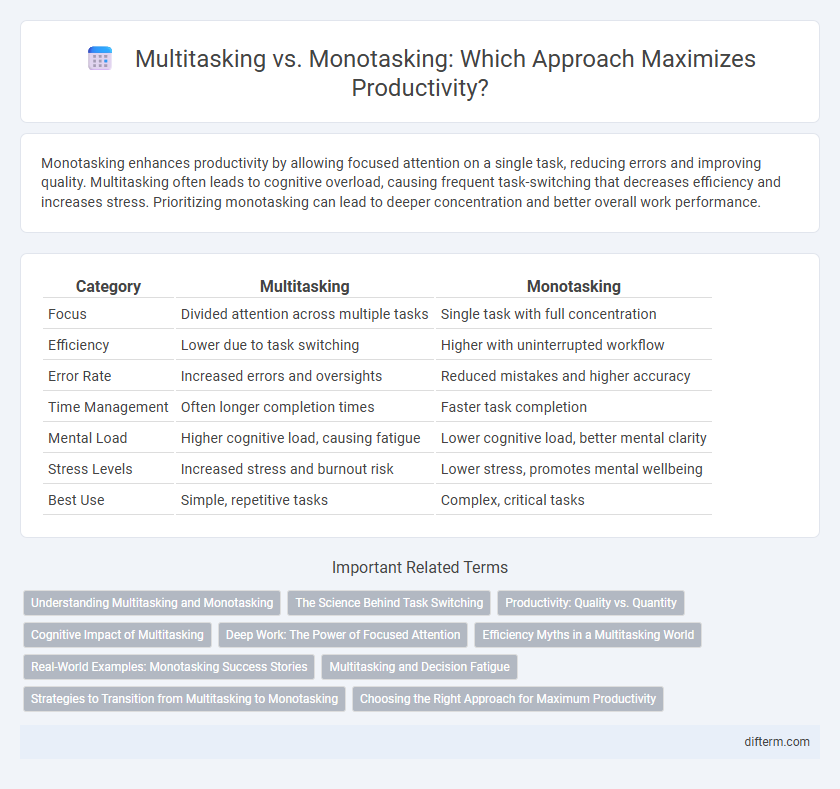Monotasking enhances productivity by allowing focused attention on a single task, reducing errors and improving quality. Multitasking often leads to cognitive overload, causing frequent task-switching that decreases efficiency and increases stress. Prioritizing monotasking can lead to deeper concentration and better overall work performance.
Table of Comparison
| Category | Multitasking | Monotasking |
|---|---|---|
| Focus | Divided attention across multiple tasks | Single task with full concentration |
| Efficiency | Lower due to task switching | Higher with uninterrupted workflow |
| Error Rate | Increased errors and oversights | Reduced mistakes and higher accuracy |
| Time Management | Often longer completion times | Faster task completion |
| Mental Load | Higher cognitive load, causing fatigue | Lower cognitive load, better mental clarity |
| Stress Levels | Increased stress and burnout risk | Lower stress, promotes mental wellbeing |
| Best Use | Simple, repetitive tasks | Complex, critical tasks |
Understanding Multitasking and Monotasking
Multitasking involves handling multiple tasks simultaneously, which can lead to reduced focus and increased cognitive load, ultimately decreasing productivity. Monotasking, or single-tasking, emphasizes dedicating full attention to one task at a time, enhancing concentration and improving the quality of work. Studies show that monotasking reduces errors and boosts efficiency compared to multitasking, which often fragments attention and increases task-switching costs.
The Science Behind Task Switching
Task switching significantly decreases productivity due to the cognitive cost of reorienting attention, which can take up to 23 minutes to regain full focus. Neuroscientific studies reveal that multitasking overloads the prefrontal cortex, impairing working memory and reducing efficiency. Monotasking enhances deep concentration and task performance by minimizing the brain's need to constantly recalibrate between multiple activities.
Productivity: Quality vs. Quantity
Multitasking often reduces overall productivity by fragmenting attention, leading to lower quality outputs despite higher task quantity. Monotasking enhances focus, improving the depth of work and resulting in higher quality outcomes even if fewer tasks are completed. Research shows that sustained attention on a single task boosts cognitive performance and reduces errors, maximizing effective productivity.
Cognitive Impact of Multitasking
Multitasking significantly increases cognitive load by forcing the brain to switch rapidly between tasks, leading to reduced attention span and decreased efficiency. Neural studies reveal that frequent task-switching impairs working memory and slows information processing speeds. This cognitive fragmentation results in more errors and longer completion times compared to monotasking, which supports deeper focus and better memory retention.
Deep Work: The Power of Focused Attention
Deep work, characterized by focused attention on a single task, significantly enhances productivity by minimizing cognitive distractions and enabling deeper learning. Multitasking often fragments attention, reducing efficiency and increasing errors, while monotasking fosters sustained concentration essential for complex problem-solving. Studies reveal that prolonged deep work sessions can boost output quality and accelerate skill acquisition.
Efficiency Myths in a Multitasking World
Multitasking is often mistaken for increased efficiency, but research shows it reduces productivity by 40% due to constant task-switching costs. Monotasking enhances focus and improves cognitive performance by allowing the brain to fully engage with one task at a time. Debunking the multitasking myth reveals that prioritizing single-task attention leads to higher-quality work and better time management.
Real-World Examples: Monotasking Success Stories
Monotasking drives productivity by allowing individuals to focus deeply on one task, such as Warren Buffett, who attributes his success to concentrating on a few key investments rather than diversifying attention. In the tech sector, companies like Apple emphasize monotasking during product development, leading to innovative breakthroughs like the iPhone. Real-world examples consistently show that avoiding multitasking reduces errors and enhances quality output, reinforcing the effectiveness of single-task focus.
Multitasking and Decision Fatigue
Multitasking increases cognitive load by forcing the brain to switch between tasks, which accelerates decision fatigue and diminishes overall productivity. Constant task-switching depletes mental resources faster than focused monotasking, leading to reduced concentration and impaired decision-making abilities. Prioritizing single-task focus can mitigate mental exhaustion and enhance efficiency by preserving cognitive energy for more critical decisions.
Strategies to Transition from Multitasking to Monotasking
Implementing monotasking strategies enhances focus and efficiency by dedicating uninterrupted time blocks to individual tasks, which reduces cognitive overload and error rates. Techniques such as time blocking, setting clear priorities, and minimizing digital distractions support this shift, enabling deeper concentration and improved task completion quality. Adopting single-task workflows not only boosts productivity but also promotes mental clarity and reduces burnout associated with constant task-switching.
Choosing the Right Approach for Maximum Productivity
Multitasking often reduces overall efficiency due to frequent task-switching that depletes cognitive resources, whereas monotasking enhances focus and deep work, leading to higher quality outcomes. Studies from cognitive psychology reveal that monotasking increases attention span and reduces errors, making it ideal for complex or creative tasks. Selecting monotasking or multitasking depends on task complexity, with monotasking suited for high-cognitive-demand activities and multitasking for simpler, repetitive tasks.
Multitasking vs Monotasking Infographic

 difterm.com
difterm.com